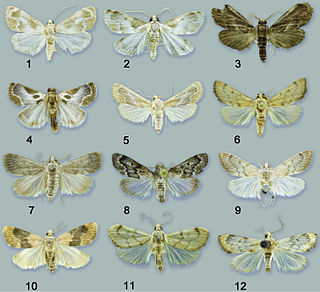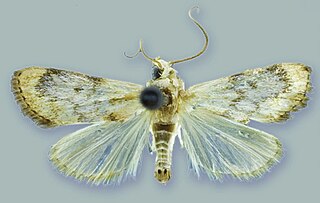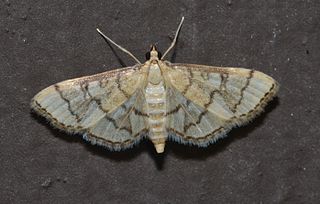
Schacontia is a genus of moths of the family Crambidae described by Harrison Gray Dyar Jr. in 1914.

Schacontia medalba is a moth of the family Crambidae described by William Schaus in 1904. It is found in Brazil and Peru.

Schacontia umbra is a moth of the family Crambidae described by Maria Alma Solis and Paul Z. Goldstein in 2013. It is found in central Ecuador.

Schacontia speciosa is a moth of the family Crambidae described by Maria Alma Solis and Paul Z. Goldstein in 2013. It is found in south-eastern Brazil.

Schacontia themis is a moth of the family Crambidae described by Maria Alma Solis and Paul Z. Goldstein in 2013. It is found on the Cayman Islands and in Brazil, Costa Rica, Cuba, the Dominican Republic, Florida, Jamaica, Mexico, Panama, Puerto Rico and Venezuela.

Schacontia rasa is a moth of the family Crambidae described by Maria Alma Solis and Paul Z. Goldstein in 2013. It is found in Mexico, Cuba and the Dominican Republic.

Schacontia nyx is a moth of the family Crambidae described by Maria Alma Solis and Paul Z. Goldstein in 2013. It is found in northern Venezuela.

Schacontia clotho is a moth of the family Crambidae described by Maria Alma Solis and Paul Z. Goldstein in 2013. It is found in southern Ecuador.

Schacontia lachesis is a moth of the family Crambidae described by Maria Alma Solis and Paul Z. Goldstein in 2013. It is found in central Brazil and Bolivia.

Schacontia atropos is a moth of the family Crambidae described by Maria Alma Solis and Paul Z. Goldstein. It is found in northern Venezuela.

Schacontia ysticalis is a moth of the family Crambidae described by Harrison Gray Dyar Jr. in 1925. It is found in Mexico, Costa Rica, Honduras, Nicaragua, Venezuela and Bolivia.

Blepharomastix ranalis, the hollow-spotted blepharomastix moth, is a species of grass moth of the family Crambidae found in the eastern and southern United States, and Mexico.
Clupeosoma astrigalis is a moth in the family Crambidae. It was described by George Hampson in 1917. It is found in Australia, where it has been recorded from Queensland.
Cliniodes ineptalis is a moth in the family Crambidae. It was described by Julius Lederer in 1863. It is found in Venezuela and Colombia.
Cliniodes opalalis is a moth in the family Crambidae. It was described by Achille Guenée in 1854. It is found in Central America, north to southern Mexico. It is also found in Cuba, Jamaica and in the Andes from Colombia to Bolivia. It has also been recorded from northern Venezuela, Trinidad and Tobago and north-eastern Brazil.
Cliniodes semilunalis is a moth in the family Crambidae. It was described by Heinrich Benno Möschler in 1890. It is found in southern Brazil, north to northern Goiás.
Cliniodes superbalis is a moth in the family Crambidae. It was described by Paul Dognin in 1911. It is found in the eastern Andes, from Bolivia to Colombia. It is possibly also present in Venezuela.
Cliniodes opertalis is a moth in the family Crambidae. It was described by James E. Hayden in 2011. It is found at low elevations in Peru, southern Venezuela and Brazil (Rondônia).
Cliniodes additalis is a moth in the family Crambidae. It was described by James E. Hayden in 2011. It is found in Mexico, where it has been recorded from San Luis Potosí.
Salbia pachyceralis is a moth in the family Crambidae. It was described by George Hampson in 1917. It is found in Panama.












